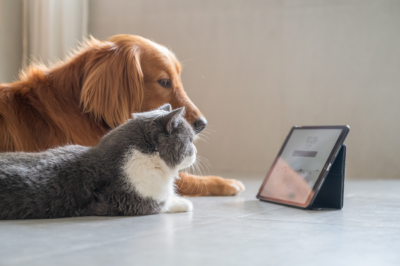
The pet technology industry is booming. In 2021, it generated USD 1.41 billion in revenue and is expected to rise to USD 3.65 billion by 2030. While some features can enhance a pet’s quality of life, pet technology can also be misused and be a detriment to a pet’s health and welfare.
Smart feeders. These feeders can solve several problems: no interruption in scheduled feedings when you’re busy or not home; prevent a pet with food sensitivities from eating another pet’s food; stop your pet from waking you up too early to be fed. They are not, however, a replacement for a pet sitter when you need to leave your pet alone for more than a day. Batteries die, power outages happen, and network servers crash, all of which could leave Fluffy hungry until you return (and potentially result in a new medical condition or even death).
Smart pet doors. Imagine an end to the repetitive “let dog in, let dog out” cycle! These automatic pet doors can be useful for your pet’s bio breaks, while also keeping neighborhood pets and wild critters out. Like smart feeders, they are no substitute for a dog walker or pet sitter, and they don’t supervise your pet while outdoors. Unless you have a fully pet-proofed yard (if it’s even possible), your pet is at risk of getting lost, hit by a car, or coming into conflict with another animal, just to name a few of the dangers. And, as with any electronic device, they can stop working and lock your pet inside or outside of your home.
Interactive cameras. Who doesn’t want to spy on their pets and perhaps catch them in the act of mischief? Or simply video chat to say, “I love you, good boy!” and then dispense a treat with the click of a button? Interactive cameras are a fun way to stay connected during those long workdays. Some pets, however, may become fearful, frustrated, and/or anxious by these mysterious drop-ins. If your pet suffers from a behavioral disorder, such as separation anxiety or certain phobias, consult your veterinarian or pet behaviorist before investing in an interactive camera.
Self-cleaning litter boxes. A self-cleaning litter box seems like the ultimate solution – convenience and peace of mind for the owner and, for the cat, the satisfaction of stepping into a clean box every time nature calls. But these high-tech boxes can do more harm than good. First, cats prefer a quiet, safe place to do their business, and the noise and motion made by these boxes can result in chronic stress for the cat. Some cats will even seek out a more desirable place to eliminate, including your laundry basket or closet. Second, observing what a cat is or isn’t leaving in the box can alert an owner when something is wrong. For instance, minimal or no urine output from a male cat can indicate a blockage, which is a life-threatening medical emergency.
Shock collars. These collars are used to deliver punishment for undesirable behaviors. They are problematic for several reasons:
- Positive reinforcement training is proven to be far more effective than punishment.
- The shocks must be painful or uncomfortable enough to be aversive for the pet and, over time, can result in chronic stress, fear, confusion, and learned helplessness.
- They do not address the underlying problem (and could potentially make it worse). For example, aggression, house soiling, and excessive barking are typically due to inadequate training, behavioral disorders, medical conditions, or any combination of the three. These behaviors need to first be addressed by a veterinarian and, if needed, a qualified trainer and/or veterinary behaviorist.
And the award for “Best of All Time” goes to…
Microchip identification. It might not be new, but it’s tried, tested, and true! For over 30 years, microchips have helped identify lost pets and reunite them with their owners. They are recommended by veterinarians and pet welfare organizations, work for the pet’s lifetime, go unnoticed by the pet, and don’t rely on batteries, servers, or wifi connections. If there is one pet tech gadget you need, it’s the reliable microchip!

